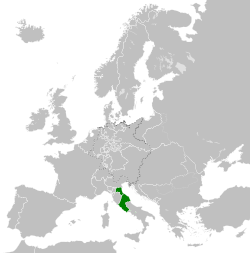Papal States
territories mostly in the Appenine Peninsula under the sovereign direct rule of the pope between 756–1870
| ||||||||||||||||||||||||||||||||||||||||||||||||||||||||||||||||||||||||||||||||||||||||||||||||
The Papal States, officially the State of the Church (Italian: Stato della Chiesa, Italian pronunciation: [ˈstato della ˈkjɛːza]; Latin: Status Ecclesiasticus;[2] also Dicio Pontificia), were a series of territories in the Italian Peninsula under the direct sovereign rule of the Pope, from the 8th century until 1870.
By 1861, much of the Papal States' territory had been conquered by the Kingdom of Italy. In 1870, the Pope lost Lazio and Rome and had no physical territory at all, except the Vatican.
Related pages
- History of Rome
- Donation of Constantine
- Italian unification
References
Other websites
🔥 Top keywords: Main PageSpecial:Search0Slash (punctuation)BlackSpecial:RecentChanges4 (number)DavidSOLID (object-oriented design)Wikipedia:AboutFile:Sexual intercourse with internal ejaculation.webmHelp:ContentsHelp:IntroductionLisa Sparxxx2023 UEFA Champions League FinalColour24-hour clockAdolf Hitler UunonaBismillahir Rahmanir Raheem6 (number)T. N. SeshanFile:ASCII-Table-wide.svg20 (number)Poor Things (movie)United StatesCristiano RonaldoList of people who have walked on the MoonAli Malikov50 (number)17 (number)The Valley (2024 TV series)GrassList of mathematical symbolsList of U.S. states and territories by time zone8 (number)List of countries by areaWikipedia:Simple talkList of largest Hindu templesRama



